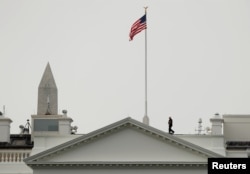After Saturday’s death of U.S. Sen. John McCain, the White House flag was lowered to half-staff, and returned to full height Monday — provoking consternation and confusion. Later Monday afternoon, it partly descended the pole again.
Throughout each tug of the rope, White House officials say they were strictly following protocol, although some other U.S. government agencies continued to fly the flag at half-staff throughout Monday.
Without a presidential proclamation, according to the U.S. Flag Code, the Stars and Stripes are to be at half-staff only “on the day of death and the following day for a Member of Congress.”
After an outcry from members of Congress, veterans’ groups, media commentators and many other citizens, Trump belatedly issued such a proclamation Monday afternoon.
In a statement released just minutes after the White House flag was again at half-staff, Trump said, “Despite our differences on policy and politics, I respect Senator John McCain’s service to our country and, in his honor, have signed a proclamation to fly the flag of the United States at half-staff until the day of his interment.”
The proclamation declares that the U.S. flag will be flown “at half-staff at the White House and upon all public buildings and grounds, at all military posts and naval stations, and on all naval vessels of the Federal Government in the District of Columbia and throughout the United States and its Territories and possessions until sunset, on the day of interment” and also directs “that the flag shall be flown at half‑staff for the same period at all United States embassies, legations, consular offices, and other facilities abroad, including all military facilities and naval vessels and stations.”
Several times earlier in the day, when White House reporters were in proximity to Trump during his meetings with visiting Kenyan President Uhuru Kenyatta, he was peppered with questions about McCain that went unanswered.
McCain died of brain cancer Saturday at the age of 81 in his home state of Arizona, a day after his family announced he was stopping treatment for the terminal disease.
Several prominent veterans’ groups on Monday had called for Trump to issue a proclamation out of respect for the late Republican senator, who spent five years in a prisoner-of-war camp in North Vietnam enduring torture, after his Navy jet was shot down over a Hanoi lake during a 1967 bombing run.
Trump should follow “long-established protocol” for the Navy captain war hero who served in the U.S. Congress for three decades, American Legion national commander Denise Rohan wrote in a letter to the president.
American Veterans, known as AMVETS, issued a statement saying it was “deeply disappointed in the lack of traditional and appropriate respects in the White House’s reaction” to McCain’s death.
“By lowering flags for not one second more than the bare minimum required by law, despite a long-standing tradition of lowering flags until the funeral, the White House is openly showcasing its blatant disrespect for Senator McCain’s many decades of service and sacrifice to our country, as well as the service of all his fellow veterans,” said AMVETS national executive director Joe Chenelly.
After the White House flag had returned to full-staff, anger spread on social media and the hashtag #NoRespect accompanied tweets criticizing Trump. Many noted that in 2009, after the death of Sen. Edward Kennedy, American flags were ordered by President Barack Obama to fly at half-staff for five days.
Animosity between McCain and Trump began during the 2016 presidential campaign. McCain, himself a two-time contender for the presidency, deemed the New York real estate businessman unfit to hold the highest office, before endorsing him as the Republican party’s nominee, only to withdraw support after old tapes emerged of Trump making vulgar comments about women.
During Trump’s presidency, McCain, who headed the armed services committee, had not hesitated to bluntly express policy differences with the White House.
McCain provoked Trump’s anger when he cast a vote with a thumbs-down gesture that prevented the repeal of the Affordable Care Act, also called Obamacare, the health coverage plan of Trump’s predecessor, and an action the president repeatedly brought up as recently as last week at political events.














